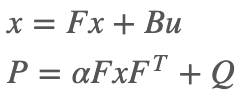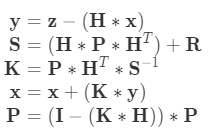1.filterpy
FilterPy是一个实现了各种滤波器的Python模块,它实现著名的卡尔曼滤波和粒子滤波器。我们可以直接调用该库完成卡尔曼滤波器实现。其中的主要模块包括:
-
filterpy.kalman
该模块主要实现了各种卡尔曼滤波器,包括常见的线性卡尔曼滤波器,扩展卡尔曼滤波器等。
-
filterpy.common
该模块主要提供支持实现滤波的各种辅助函数,其中计算噪声矩阵的函数,线性方程离散化的函数等。
-
filterpy.stats
该模块提供与滤波相关的统计函数,包括多元高斯算法,对数似然算法,PDF及协方差等。
-
filterpy.monte_carlo
该模块提供了马尔科夫链蒙特卡洛算法,主要用于粒子滤波。
开源代码在:
https://github.com/rlabbe/filterpy/tree/master/filterpy/kalman
我们介绍下卡尔曼滤波器的实现,主要分为预测和更新两个阶段,在进行滤波之前,需要先进行初始化:
- 初始化
预先设定状态变量dim_x和观测变量维度dim_z、协方差矩阵P、运动形式和观测矩阵H等,一般各个协方差矩阵都会初始化为单位矩阵,根据特定的场景需要相应的设置。
def __init__(self, dim_x, dim_z, dim_u = 0, x = None, P = None,Q = None, B = None, F = None, H = None, R = None):"""Kalman FilterRefer to http:/github.com/rlabbe/filterpyMethod-----------------------------------------Predict | Update-----------------------------------------| K = PH^T(HPH^T + R)^-1x = Fx + Bu | y = z - HxP = FPF^T + Q | x = x + Ky| P = (1 - KH)P| S = HPH^T + R-----------------------------------------note: In update unit, here is a more numerically stable way: P = (I-KH)P(I-KH)' + KRK'Parameters----------dim_x: intdims of state variables, eg:(x,y,vx,vy)->4dim_z: intdims of observation variables, eg:(x,y)->2dim_u: intdims of control variables,eg: a->1p = p + vt + 0.5at^2v = v + at=>[p;v] = [1,t;0,1][p;v] + [0.5t^2;t]a"""assert dim_x >= 1, 'dim_x must be 1 or greater'assert dim_z >= 1, 'dim_z must be 1 or greater'assert dim_u >= 0, 'dim_u must be 0 or greater'self.dim_x = dim_xself.dim_z = dim_zself.dim_u = dim_u# initialization# predictself.x = np.zeros((dim_x, 1)) if x is None else x # stateself.P = np.eye(dim_x) if P is None else P # uncertainty covarianceself.Q = np.eye(dim_x) if Q is None else Q # process uncertainty for predictionself.B = None if B is None else B # control transition matrixself.F = np.eye(dim_x) if F is None else F # state transition matrix# updateself.H = np.zeros((dim_z, dim_x)) if H is None else H # Measurement function z=Hxself.R = np.eye(dim_z) if R is None else R # observation uncertaintyself._alpha_sq = 1. # fading memory controlself.z = np.array([[None] * self.dim_z]).T # observationself.K = np.zeros((dim_x, dim_z)) # kalman gainself.y = np.zeros((dim_z, 1)) # estimation errorself.S = np.zeros((dim_z, dim_z)) # system uncertainty, S = HPH^T + Rself.SI = np.zeros((dim_z, dim_z)) # inverse system uncertainty, SI = S^-1self.inv = np.linalg.invself._mahalanobis = None # Mahalanobis distance of measurementself.latest_state = 'init' # last process name- 预测阶段
接下来进入预测环节,为了保证通用性,引入了遗忘系数α,其作用在于调节对过往信息的依赖程度,α越大对历史信息的依赖越小:

代码如下:
def predict(self, u = None, B = None, F = None, Q = None):"""Predict next state (prior) using the Kalman filter state propagation equations:x = Fx + BuP = fading_memory*FPF^T + QParameters----------u : ndarrayOptional control vector. If not `None`, it is multiplied by Bto create the control input into the system.B : ndarray of (dim_x, dim_z), or NoneOptional control transition matrix; a value of Nonewill cause the filter to use `self.B`.F : ndarray of (dim_x, dim_x), or NoneOptional state transition matrix; a value of Nonewill cause the filter to use `self.F`.Q : ndarray of (dim_x, dim_x), scalar, or NoneOptional process noise matrix; a value of None will cause thefilter to use `self.Q`."""if B is None:B = self.Bif F is None:F = self.Fif Q is None:Q = self.Qelif np.isscalar(Q):Q = np.eye(self.dim_x) * Q# x = Fx + Buif B is not None and u is not None:self.x = F @ self.x + B @ uelse:self.x = F @ self.x# P = fading_memory*FPF' + Qself.P = self._alpha_sq * (F @ self.P @ F.T) + Qself.latest_state = 'predict'- 更新阶段
按下式进行状态的更新:

也可以写为:

其中,y是测量余量,S是测量余量的协方差矩阵。
在实际应用中会做一些微调,使协方差矩阵为:

代码如下:
def update(self, z, R = None, H = None):"""Update Process, add a new measurement (z) to the Kalman filter.K = PH^T(HPH^T + R)^-1y = z - Hxx = x + KyP = (1 - KH)P or P = (I-KH)P(I-KH)' + KRK'If z is None, nothing is computed.Parameters----------z : (dim_z, 1): array_likemeasurement for this update. z can be a scalar if dim_z is 1,otherwise it must be convertible to a column vector.R : ndarray, scalar, or NoneOptionally provide R to override the measurement noise for thisone call, otherwise self.R will be used.H : ndarray, or NoneOptionally provide H to override the measurement function for thisone call, otherwise self.H will be used."""if z is None:self.z = np.array([[None] * self.dim_z]).Tself.y = np.zeros((self.dim_z, 1))returnz = reshape_z(z, self.dim_z, self.x.ndim)if R is None:R = self.Relif np.isscalar(R):R = np.eye(self.dim_z) * Rif H is None:H = self.Hif self.latest_state == 'predict':# common subexpression for speedPHT = self.P @ H.T# S = HPH' + R# project system uncertainty into measurement spaceself.S = H @ PHT + Rself.SI = self.inv(self.S)# K = PH'inv(S)# map system uncertainty into kalman gainself.K = PHT @ self.SI# P = (I-KH)P(I-KH)' + KRK'# This is more numerically stable and works for non-optimal K vs# the equation P = (I-KH)P usually seen in the literature.I_KH = np.eye(self.dim_x) - self.K @ Hself.P = I_KH @ self.P @ I_KH.T + self.K @ R @ self.K.T# y = z - Hx# error (residual) between measurement and predictionself.y = z - H @ self.xself._mahalanobis = math.sqrt(float(self.y.T @ self.SI @ self.y))# x = x + Ky# predict new x with residual scaled by the kalman gainself.x = self.x + self.K @ self.yself.latest_state = 'update'那接下来,我们就是用filterpy中的卡尔曼滤波器方法完成小车位置的预测。
2.小车案例
现在利用卡尔曼滤波对小车的运动状态进行预测。主要流程如下所示:
- 导入相应的工具包
- 小车运动数据生成
- 参数初始化
- 利用卡尔曼滤波进行小车状态预测
- 可视化:观察参数的变化与结果
下面我们看下整个流程实现:
- 导入包
from matplotlib import pyplot as plt
import seaborn as sns
import numpy as np
from filterpy.kalman import KalmanFilter- 小车运动数据生成
在这里我们假设小车作速度为1的匀速运动
# 生成1000个位置,从1到1000,是小车的实际位置
z = np.linspace(1,1000,1000)
# 添加噪声
mu,sigma = 0,1
noise = np.random.normal(mu,sigma,1000)
# 小车位置的观测值
z_nosie = z+noise- 参数初始化
# dim_x 状态向量size,在该例中为[p,v],即位置和速度,size=2
# dim_z 测量向量size,假设小车为匀速,速度为1,测量向量只观测位置,size=1
my_filter = KalmanFilter(dim_x=2, dim_z=1)# 定义卡尔曼滤波中所需的参数
# x 初始状态为[0,0],即初始位置为0,速度为0.
# 这个初始值不是非常重要,在利用观测值进行更新迭代后会接近于真实值
my_filter.x = np.array([[0.], [0.]])# p 协方差矩阵,表示状态向量内位置与速度的相关性
# 假设速度与位置没关系,协方差矩阵为[[1,0],[0,1]]
my_filter.P = np.array([[1., 0.], [0., 1.]])# F 初始的状态转移矩阵,假设为匀速运动模型,可将其设为如下所示
my_filter.F = np.array([[1., 1.], [0., 1.]])# Q 状态转移协方差矩阵,也就是外界噪声,
# 在该例中假设小车匀速,外界干扰小,所以我们对F非常确定,觉得F一定不会出错,所以Q设的很小
my_filter.Q = np.array([[0.0001, 0.], [0., 0.0001]])# 观测矩阵 Hx = p
# 利用观测数据对预测进行更新,观测矩阵的左边一项不能设置成0
my_filter.H = np.array([[1, 0]])
# R 测量噪声,方差为1
my_filter.R = 1- 卡尔曼滤波进行预测
# 保存卡尔曼滤波过程中的位置和速度
z_new_list = []
v_new_list = []
# 对于每一个观测值,进行一次卡尔曼滤波
for k in range(len(z_nosie)):# 预测过程 my_filter.predict()# 利用观测值进行更新my_filter.update(z_nosie[k])# do something with the outputx = my_filter.x# 收集卡尔曼滤波后的速度和位置信息z_new_list.append(x[0][0])v_new_list.append(x[1][0])-
可视化
-
预测误差的可视化
# 位移的偏差 dif_list = [] for k in range(len(z)):dif_list.append(z_new_list[k]-z[k]) # 速度的偏差 v_dif_list = [] for k in range(len(z)):v_dif_list.append(v_new_list[k]-1) plt.figure(figsize=(20,9)) plt.subplot(1,2,1) plt.xlim(-50,1050) plt.ylim(-3.0,3.0) plt.scatter(range(len(z)),dif_list,color ='b',label = "位置偏差") plt.scatter(range(len(z)),v_dif_list,color ='y',label = "速度偏差") plt.legend()运行结果如下所示:

2.卡尔曼滤波器参数的变化
首先定义方法将卡尔曼滤波器的参数堆叠成一个矩阵,右下角补0,我们看一下参数的变化。
# 定义一个方法将卡尔曼滤波器的参数堆叠成一个矩阵,右下角补0
def filter_comb(p, f, q, h, r):a = np.hstack((p, f))b = np.array([r, 0])b = np.vstack([h, b])b = np.hstack((q, b))a = np.vstack((a, b))return a
对参数变化进行可视化:
# 保存卡尔曼滤波过程中的位置和速度
z_new_list = []
v_new_list = []
# 对于每一个观测值,进行一次卡尔曼滤波
for k in range(1):# 预测过程 my_filter.predict()# 利用观测值进行更新my_filter.update(z_nosie[k])# do something with the outputx = my_filter.xc = filter_comb(my_filter.P,my_filter.F,my_filter.Q,my_filter.H,my_filter.R)plt.figure(figsize=(32,18))sns.set(font_scale=4)#sns.heatmap(c,square=True,annot=True,xticklabels=False,yticklabels==False,cbar=False)sns.heatmap(c,square=True,annot=True,xticklabels=False,yticklabels=False,cbar=False)对比变换:

从图中可以看出变化的P,其他的参数F,Q,H,R为变换。另外状态变量x和卡尔曼系数K也是变化的。
3.概率密度函数
为了验证卡尔曼滤波的结果优于测量的结果,绘制预测结果误差和测量误差的概率密度函数:
# 生成概率密度图像
z_noise_list_std = np.std(noise)
z_noise_list_avg = np.mean(noise)
z_filterd_list_std = np.std(dif_list)
import seaborn as sns
plt.figure(figsize=(16,9))
ax = sns.kdeplot(noise,shade=True,color="r",label="std=%.3f"%z_noise_list_std)
ax = sns.kdeplot(dif_list,shade=True,color="g",label="std=%.3f"%z_filterd_list_std)结果如下:

总结:
1.了解filterpy工具包
FilterPy是一个实现了各种滤波器的Python模块,它实现著名的卡尔曼滤波和粒子滤波器。直接调用该库完成卡尔曼滤波器实现。
2.知道卡尔曼滤波的实现过程
卡尔曼滤波器的实现,主要分为预测和更新两个阶段,在进行滤波之前,需要先进行初始化
- 初始化
预先设定状态变量和观测变量维度、协方差矩阵、运动形式和转换矩阵
- 预测
对状态变量X和协方差P进行预测
- 更新
利用观测结果对卡尔曼滤波的结果进行修征
3.能够利用卡尔曼滤波器完成小车目标状态的预测
-
导入相应的工具包
-
小车运动数据生成:匀速运动的小车模型
-
参数初始化:对卡尔曼滤波的参数进行初始化,包括状态变量和观测变量维度、协方差矩阵、运动形式和转换矩阵等
-
利用卡尔曼滤波进行小车状态预测:使用Filterpy工具包,调用predict和update完成小车状态的预测
-
可视化:观察参数的变化与结果
1.预测误差的分布:p,v
2.参数的变化:参数中变化的是X,P,K,不变的是F,Q,H,R
- 误差的概率密度函数:卡尔曼预测的结果优于测量结果






。 - connect (111: 拒绝连接))





)
)


 Redis设计思路学习与总结)

学习笔记)
)